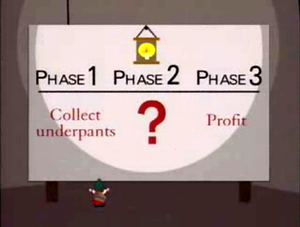We heard someone recently expressing disappointment with a marketing initiative they had tried. “Tried” is the right word here, and it often is in marketing. Someone sells you an idea, you figure you’ll try it out, and at the end of the campaign you’re disappointed by the ROI. So you move on to something else.
As I was listening to this familiar story, though, I had to wonder: what had they thought would happen? As far as I could tell, they hadn’t started out with a clear goal. I didn’t hear about the hoped-for customer’s path to purchase. I didn’t hear about goals or comparisons between the cost and the expected benefits.
Was the idea to increase visibility and brand awareness? If so, it wouldn’t make sense to judge success by short-term increases in sales. If the idea was to increase sales — well, how did they think they were going to make those sales?
It makes me think of the gnomes in South Park whose business plan is Collect Underpants > ? > Profit. It’s essential to have that question mark replaced by a clear strategy before you go full steam ahead. In fact, you should have something good for Phase 2 before you collect any underpants.
Some marketing strategies take a lot of time. One of our clients has a path to purchase that looks like this:
We can see it in their web analytics. People often visit a dozen or more times before they buy. In order to increase visits and therefore sales, we can see that it makes sense to keep them active on social media, to continue SEO, and to make sure there is plenty of great content on the website for visitors to enjoy.
If we want to speed up the process and shorten the path between Phase 1 and Phase 3, we’ll need to change something. Right now, the client’s website is a valuable resource for the community they target, but they could be more aggressive about sales. Adding more sales-oriented email marketing and more aggressive CTAs could make the difference.
Another client has a path to purchase like this:
Taking 5-12 visits to sign up is normal; in fact, it’s a truism in marketing that people have to see your message that many times before they take action, and this client is just one more piece of evidence showing that this is true. Increasing memberships could mean more ads, more involvement in social media, adding email marketing to the mix — or sitting back and waiting for time to bring natural organic increases, if there are no more resources to be devoted to the effort right now.
Here’s one more example:
This client has a shorter path to purchase than the previous examples. People often sign up for free offers on their first visit, and a good proportion of those people come back to the website or call and make an appointment. For this client, it would make sense to focus on Phase 1. Since two and three show good conversion rates, it’s a numbers game for this client. They’re using a lot of different kinds of advertising, so a sensible strategy would be to identify the effectiveness of the approaches they’re currently taking, to consider and test other methods, and then to focus their resources on the things that work best.
Here are some questions to think about next time you think about your marketing:
- What outcome do you want? It might be increased brand awareness, a higher conversion rate at your website, or more sales.
- How will you know if you succeed? Getting better all the time is great, but specific goals keep you from being disappointed. If you run a month-long campaign and your typical monthly sales are N, your goals should be N+X, not Nx8, unless you have a good reason to expect Nx8 (like maybe you’re spending eight times as much as you usually do).
- What is the current path to that goal? How are people finding and buying your product right now? Build on your strengths… or at least know what’s happening now and work with it.
- What needs to change? You may need to increase or decrease something or to change it. If you’re considering a new initiative that doesn’t fit with your current success path, you have to figure out how you’ll get people from the new path to the destination you have for them, and how you’ll track it. For example, if you add TV to your marketing mix, you could come up with a call to action and a special phone number or URL
- What steps need to be taken, who’s going to take them, and when? There are a lot of moving parts in your business, so you have to make sure that everyone is ready. If you’re promoting one product, will you have enough on hand to cover the sales if your marketing reaches its goals?
A clear strategy is essential if you want clear success.





Leave a Reply